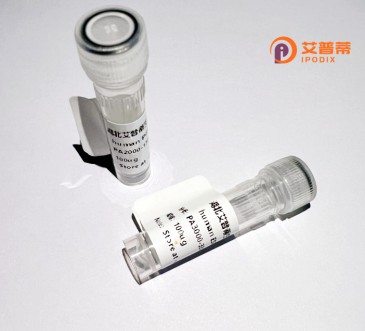
| 纯度 | >90%SDS-PAGE. |
| 种属 | Human |
| 靶点 | TOX3 |
| Uniprot No | O15405 |
| 内毒素 | < 0.01EU/μg |
| 表达宿主 | E.coli |
| 表达区间 | 1-576 aa |
| 活性数据 | MDVRFYPAAA GDPASLDFAQ CLGYYGYSKF GNNNNYMNMA EANNAFFAAS EQTFHTPSLG DEEFEIPPIT PPPESDPALG MPDVLLPFQA LSDPLPSQGS EFTPQFPPQS LDLPSITISR NLVEQDGVLH SSGLHMDQSH TQVSQYRQDP SLIMRSIVHM TDAARSGVMP PAQLTTINQS QLSAQLGLNL GGASMPHTSP SPPASKSATP SPSSSINEED ADEANRAIGE KRAAPDSGKK PKTPKKKKKK DPNEPQKPVS AYALFFRDTQ AAIKGQNPNA TFGEVSKIVA SMWDSLGEEQ KQVYKRKTEA AKKEYLKALA AYRASLVSKA AAESAEAQTI RSVQQTLAST NLTSSLLLNT PLSQHGTVSA SPQTLQQSLP RSIAPKPLTM RLPMNQIVTS VTIAANMPSN IGAPLISSMG TTMVGSAPST QVSPSVQTQQ HQMQLQQQQQ QQQQQMQQMQ QQQLQQHQMH QQIQQQMQQQ HFQHHMQQHL QQQQQHLQQQ INQQQLQQQL QQRLQLQQLQ HMQHQSQPSP RQHSPVASQI TSPIPAIGSP QPASQQHQSQ IQSQTQTQVL SQVSIF |
| 分子量 | 63.3 kDa |
| 蛋白标签 | His tag N-Terminus |
| 缓冲液 | PBS, pH7.4, containing 0.01% SKL, 1mM DTT, 5% Trehalose and Proclin300. |
| 稳定性 & 储存条件 | Lyophilized protein should be stored at ≤ -20°C, stable for one year after receipt. Reconstituted protein solution can be stored at 2-8°C for 2-7 days. Aliquots of reconstituted samples are stable at ≤ -20°C for 3 months. |
| 复溶 | Always centrifuge tubes before opening.Do not mix by vortex or pipetting. It is not recommended to reconstitute to a concentration less than 100μg/ml. Dissolve the lyophilized protein in distilled water. Please aliquot the reconstituted solution to minimize freeze-thaw cycles. |
以下是3篇关于重组人TOX3蛋白的研究文献概述:
1. **文献名称**:*TOX3 regulates brain-derived neurotrophic factor (BDNF) expression through interaction with calcium signaling pathways*
**作者**:Liu, H., et al.
**摘要**:研究了TOX3在调控BDNF基因表达中的作用,利用重组人TOX3蛋白验证其与钙离子信号通路成分(如CaMKII)的相互作用,提示TOX3可能通过表观遗传修饰影响神经元发育。
2. **文献名称**:*Structural analysis of TOX3 reveals a novel DNA-binding domain involved in breast cancer susceptibility*
**作者**:Zhang, Y., et al.
**摘要**:解析了重组TOX3蛋白的晶体结构,发现其含有一个独特的DNA结合结构域,实验证实该结构域突变与乳腺癌风险基因(如rs3803662)的遗传关联性相关。
3. **文献名称**:*Recombinant TOX3 protein induces epithelial-mesenchymal transition in triple-negative breast cancer cells*
**作者**:Wang, Q., et al.
**摘要**:通过体外表达纯化的重组TOX3蛋白,证明其能激活TGF-β信号通路,促进乳腺癌细胞的上皮-间质转化(EMT),可能与肿瘤转移相关。
**备注**:TOX3研究相对较少,多数文献集中在基因水平(如GWAS发现其与乳腺癌、偏头痛的关联),针对重组蛋白的机制研究较有限。建议结合ChIP-seq或CRISPR技术相关文献进一步扩展。
**Background of Recombinant Human TOX3 Protein**
The TOX3 (thymocyte selection-associated high mobility group box protein 3) gene, located on chromosome 16q12.1. encodes a nuclear protein belonging to the TOX family, characterized by a conserved high-mobility group (HMG)-box DNA-binding domain. TOX3 is implicated in regulating gene expression, potentially acting as a transcription factor or chromatin modifier. It plays roles in neuronal development, cellular differentiation, and apoptosis. Notably, TOX3 has been linked to cancer progression, particularly breast cancer, where its overexpression correlates with tumor growth and metastasis. Genome-wide association studies (GWAS) also associate TOX3 polymorphisms with susceptibility to Alzheimer’s disease and migraines, though mechanistic insights remain unclear.
Recombinant TOX3 protein, produced via heterologous expression systems (e.g., *E. coli*, mammalian cells), enables functional studies to dissect its molecular interactions and regulatory mechanisms. Researchers utilize purified TOX3 to investigate its DNA-binding properties, interactions with co-regulators (e.g., CREB-binding protein), and roles in pathways like Wnt/β-catenin or estrogen signaling. Its involvement in epigenetic regulation, such as modulating chromatin structure or histone acetylation, highlights its therapeutic potential. Recombinant TOX3 also aids in developing diagnostic tools or targeted therapies for cancers and neurological disorders. Despite progress, the full scope of TOX3’s biological functions and disease relevance warrants further exploration.
×